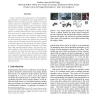Free Online Productivity Tools
i2Speak
i2Symbol
i2OCR
iTex2Img
iWeb2Print
iWeb2Shot
i2Type
iPdf2Split
iPdf2Merge
i2Bopomofo
i2Arabic
i2Style
i2Image
i2PDF
iLatex2Rtf
Sci2ools
ICCV
2005
IEEE
2005
IEEE
Creating Efficient Codebooks for Visual Recognition
Visual codebook based quantization of robust appearance descriptors extracted from local image patches is an effective means of capturing image statistics for texture analysis and scene classification. Codebooks are usually constructed by using a method such as k-means to cluster the descriptor vectors of patches sampled either densely (`textons') or sparsely (`bags of features' based on keypoints or salience measures) from a set of training images. This works well for texture analysis in homogeneous images, but the images that arise in natural object recognition tasks have far less uniform statistics. We show that for dense sampling, k-means over-adapts to this, clustering centres almost exclusively around the densest few regions in descriptor space and thus failing to code other informative regions. This gives suboptimal codes that are no better than using randomly selected centres. We describe a scalable acceptance-radius based clusterer that generates better codebooks an...
Codebook Based Quantization | Computer Vision | Dense Codebook | ICCV 2005 | Image Classification Tasks | Keypoint Based Ones | Object Recognition Tasks |
| Added | 15 Oct 2009 |
| Updated | 15 Oct 2009 |
| Type | Conference |
| Year | 2005 |
| Where | ICCV |
| Authors | Bill Triggs, Frédéric Jurie |
Comments (0)

